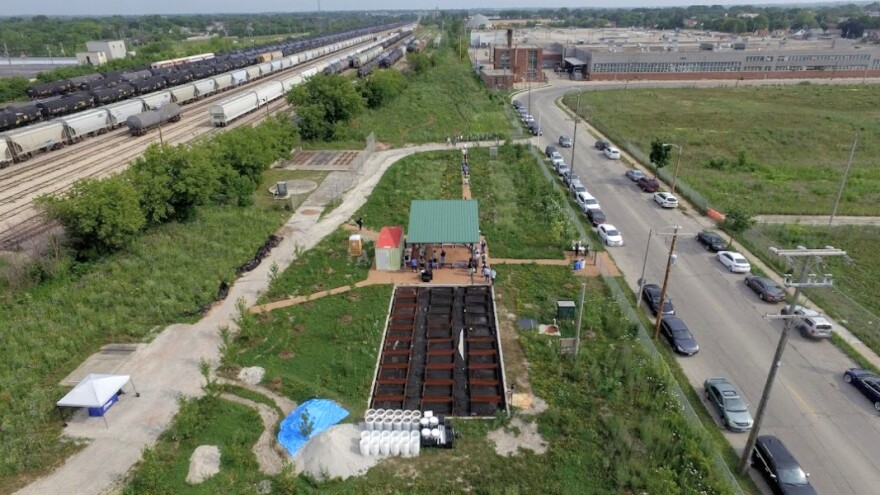Not long ago, a desolate parcel of land just north of Capitol Drive, hugged by train tracks to the west and 31st Street to the east, was utterly blighted. Today, it's a burgeoning green space called Green Tech Station designed to capture stormwater. The project can be toured this Saturday as part of Doors Open Milwaukee.
The Wisconsin Independent Oil Company originally operated on the site, according to Tory Kress with the City of Milwaukee's Redevelopment Authority.
"We knew that there was some brownfield issues because there was bulk oil storage on the site for a long, long time; so we were concerned about what we would find out here," Kress said. "We wrote an EPA brownfield clean-up grant, but we kind of didn't know exactly how we were going to bring it out of the ground."

That’s where partners, starting with Northwest Side Community Development Corporation, entered the picture. Community Development Manager Sarah Bregant said her office is just a short walk away.
“So we can see the space from our window and once we saw that the city foreclosed, [we thought] like what’s next for this site?" Bregant said. "Maybe we can step in as a nonprofit, write some grants, maybe secure some different funding and really make this a cool green space."
Bregant said as partners multiplied and their vision evolved: “Now it’s an environmental education destination focused around water, around outdoor education amenities. So we can have groups visit."
Student interns painted benches with water-themed motifs clustered beneath a pavilion at the heart of the space.
“And the other big piece of art is the bottle cap mosaic that is mounted on the fence, so there are about 12,000 bottle caps that were collected and that were screwed onto those 4x4-foot panels and then mounted on the fence."
They spell out the words Green Tech Station.

On the infrastructure side of things, the station’s bioswales and wetland-mimicking systems are designed to capture up to 100,000 gallons of stormwater at a time.
An underground cistern holds 20,000 gallons that can irrigate plants and trees or can be slowly released to the sewer system.
Hydrologist Nick Buer said his agency, the US Geological Survey, is in on the project too – tracking rainfall as well as contaminants conveyed by stormwater onto the site.

“We’re looking at everything. Your standard stuff like phosphorus, sediments, metals, but then we’re going to start to look at PAHs, pesticides, pharmaceuticals; kind of anything we can throw at our urban environment that’s out there," Buer said. "We’re trying to see what’s coming off into the water and then what the soil is filtering out, basically. So what all these plants and what the soil is doing to remove that."
Tony Parolari teaches civil engineering at Marquette University. He’s tapping into another Green Tech Station vision to encourage green infrastructure innovation.
Parolari’s students recently filled white plastic barrels – think a rain barrel without a top – with different combinations of soils.
“Half of the barrels have boiler slag, [an] industrial bioproduct, mixed into them that has been reported to be good at absorbing phosphorus,” Parolari said. "In general we’re interested in how can we better design the soils and vegetation in green infrastructure, in bioswales specifically."
Not far from Parolari’s project, researchers and entrepreneurs will be able to pilot green technologies on a series of 30 test cells constructed above the large underground cistern.

The testing zone was the brainchild of another local partner, Reflo.
“One of the thoughts [is to test] different types of porous pavement and see how well they do with Wisconsin conditions,” said Reflo intern coordinator Wilniesha Smith. “And be able to demonstrate with the cistern underneath, instead of bringing water on site, we have the water that can be pumped backed out.”
Sarah Bregant with the Northwest Side Community Development Corporation, thinks the Green Tech Station has incredible potential, including career exploration.
“And reimagining what the 30th Street Corridor can be on some of the parcels that we have been left behind from Milwaukee’s industrial past," Bregant said. "But there are other ways that we can reimagine these sites that serve a 21st century purpose and then really sort of revitalizing the land and nature in the process.”
Have an environmental question you'd like WUWM's Susan Bence to investigate? Submit below. (If the module isn't appearing, please refresh the page.)
_







